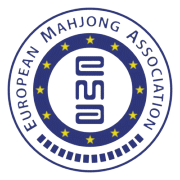European Mahjong Association: Difference between revisions
m (→Membership) |
(update Ukrainian player counter) |
||
| Line 92: | Line 92: | ||
|align=center| 19 ||align=left| Poland ||align=right| 28 | |align=center| 19 ||align=left| Poland ||align=right| 28 | ||
|- | |- | ||
|align=center| 21 ||align=left| Ukraine ||align=right| | |align=center| 21 ||align=left| Ukraine ||align=right| 39 | ||
|- | |- | ||
|align=center| 22 ||align=left| Czech Republic ||align=right| 3 | |align=center| 22 ||align=left| Czech Republic ||align=right| 3 | ||
Revision as of 10:56, 29 September 2015
 EMA logo | |
| Location | Europe |
|---|---|
| Inception | 2005 |
| Leader |
Tina Christensen President |
| Members | 19 associations |
| European Mahjong Association ruleset | |
|---|---|
| Kuitan, atozuke | nashi-ari |
| Starting points | 0 |
| Ending points (Target) |
0 |
| Negative score | Limitless |
| Oka (total ante) |
0 |
| Uma (placement bonus) |
1st: +30,000; 2nd: +10,000; 3rd: -10,000; 4th: -30,000. |
| Multiple win cases | 3 |
| Call precedence | 3.0 s |
| Dora settings | All |
| Renchan setting | Tenpai-renchan |
| Abortive draws | All |
| Specific House rules |
Irregular furiten, red fives but no kuitan. |
The European Mahjong Association (EMA) is an organization whose purpose is "to encourage, disseminate and coordinate the playing of mahjong in Europe". Its membership currently consists only of national Mahjong organizations located in Europe, each nation being treated equally during procedural votes. Players are technically members of their national organizations and not directly of the EMA. The EMA does coordinate pan-european initiatives such as a coordinated registration and player database and the ranking system for members of the various national organizations. While a best effort is made to try to disseminate and coordinate the release of multilingual documentation, the default language is English. The current president of the EMA is Tina Christensen.
Membership
The EMA was created in 2005 with 7 original members. At present, there are 19 members:[1]
- [01] Austria: Österreichischer Mahjong Verband (2005)
- [03] Denmark: Mahjong Danmark (2005)
- [04] France: Fédération Française de Mah-Jong (2005)
- [05] Germany: Deutsche Mah-Jongg Liga (2005)
- [06] Hungary: Magyar Mah-jong Szövetség (2005)
- [07] Italy: Federazione Italiana Mah Jong (2005)
- [08] Netherlands: Nederlandse Mahjong Bond (2005)
- [02] Belgium: Belgian Mahjong Association (2009)
- [09] Sweden: Svenska Mahjongförbundet (2009)
- [10] Spain: Federación Española de mahjong (2009)
- [12] Portugal: União de Mahjong de Portugal (2009)
- [14] Finland: Suomen Mahjong-liitto (2009)
- [15] Russia: Russian Mahjong Federation (2009)
- [17] Slovakia: Slovenský Mahjongový Zväz (2009)
- [11] United Kingdom: United Kingdom Mahjong Association (2011)
- [19] Poland: Polska Liga Mahjonga (2011)
- [16] Switzerland: Association Suisse de Mah-Jong - Associazione Svizzera di Mah-Jong - Schweizerischer Mah-Jong Verein (ASM-SMV) (2013)
- [21] Ukraine: Ukrainian Mahjong Federation (2013)
- [22] Czech Republic: Česká asociace mahjongu (ČAMJ) (2013)
The missing numbers 13 and 20 were meant to designate Bosnia and Herzegovina as well as Turkey, according to past archives. The status for the missing number 18 is unknown.
Future Membership
At this time, it is unknown if new member organizations will be welcomed into the EMA for the next General Assembly.
Participation
As of July 2014, there are 306 active players (players with 2 or more Riichi tournaments played within the last 3 years)
| Code | Country | Players |
|---|---|---|
| 01 | Austria | 22 |
| 02 | Belgium | 1 |
| 03 | Denmark | 23 |
| 04 | France | 51 |
| 05 | Germany | 23 |
| 06 | Hungary | 0 |
| 07 | Italy | 1 |
| 08 | Netherlands | 44 |
| 09 | Sweden | 11 |
| 10 | Spain | 0 |
| 11 | Great Britain | 20 |
| 12 | Portugal | 1 |
| 14 | Finland | 3 |
| 15 | Russia | 59 |
| 16 | Switzerland | 0 |
| 17 | Slovakia | 9 |
| 19 | Poland | 28 |
| 21 | Ukraine | 39 |
| 22 | Czech Republic | 3 |
Rulesets
EMA currently uses two rulesets; one for Japanese Mahjong and another for Chinese Mahjong. For Chinese Mahjong, EMA uses MCR ruleset that is regulated by Chinese authorities and used in the Chinese Mahjong World Championship. For Japanese Mahjong, EMA has their own Riichi ruleset that is based on Dutch and Danish customs. Notable features include the lack of kuitan and kuikae and the inclusion of aka dora and ryanhan shibari. EMA has estabilished a Riichi Rules Committee to consider refinement and possible revision of the ruleset.
Tournaments and Ranking
Each national organization can apply to EMA to have their tournaments officially ranked. Each member country can hold one national championship (MERS-2) and two other events (MERS-1) per ruleset per year. EMA also admisters European Championships, held every 2-3 years, for both rulesets.
Ranking system
EMA's Mahjong Europe Ranking System (MERS) has separate ranking lists for Chinese Mahjong (MCR) and Japanese Mahjong (RCR) rulesets. Both operate in the same way. From each tournament a player participates in, they receive a rating from 0 to 1000, where 0 corresponds to last place and 1000 to first. Then their overall rating from 0 to 1000 is calculated as a weighted average of the tournament results. [2]
Quotas
For Championship events, EMA will allocate seats to each member country by using their quota system.[3]